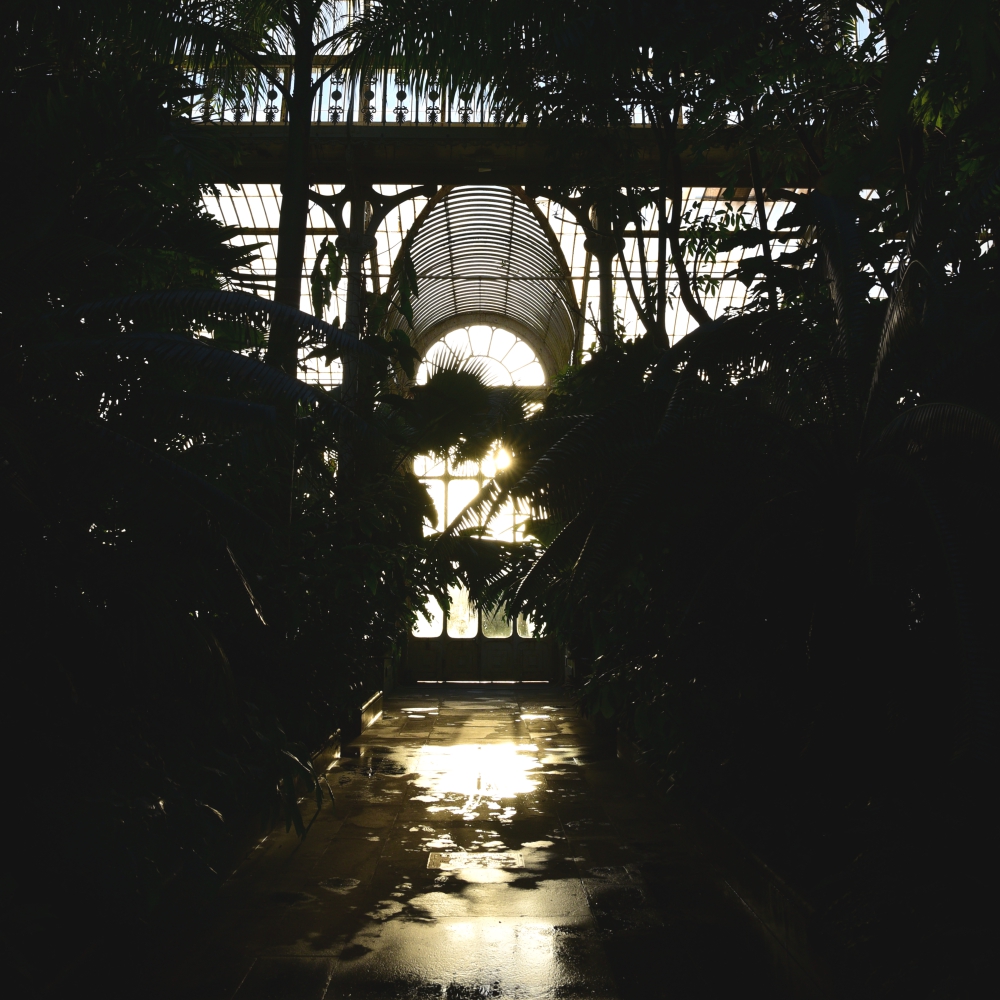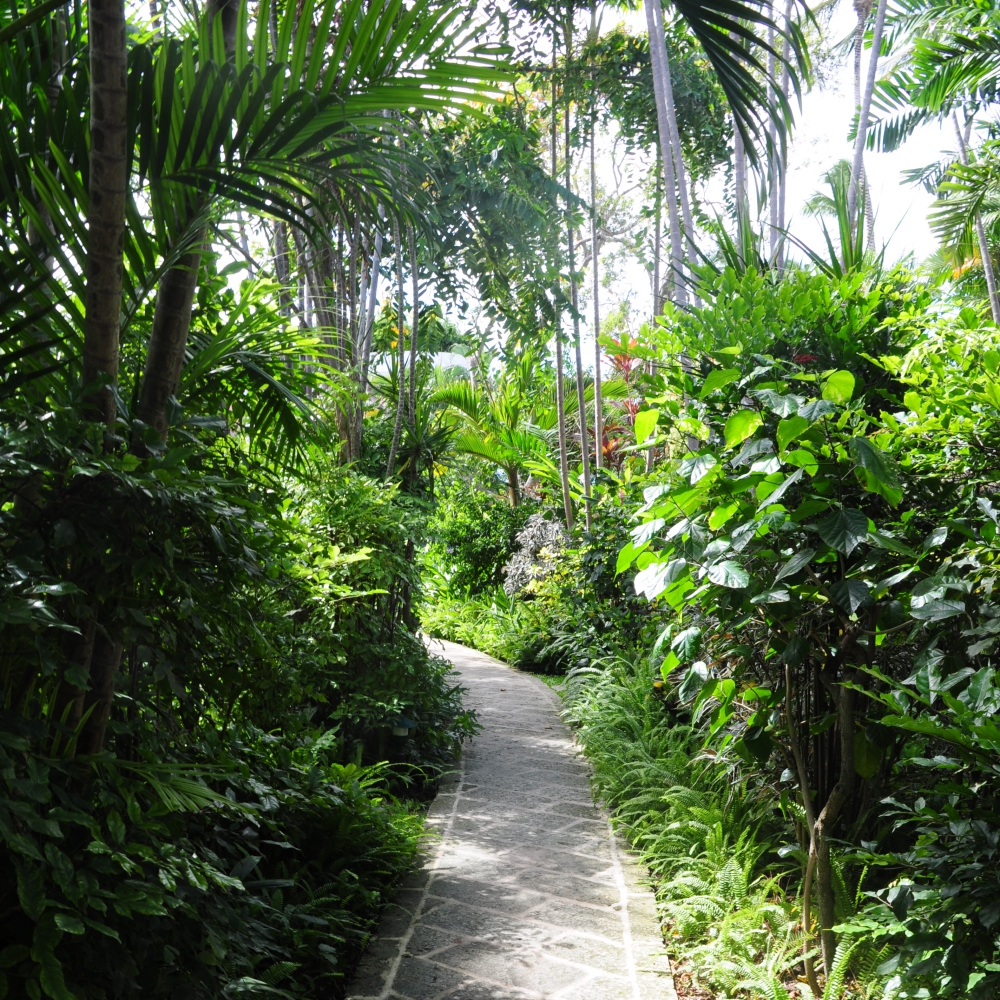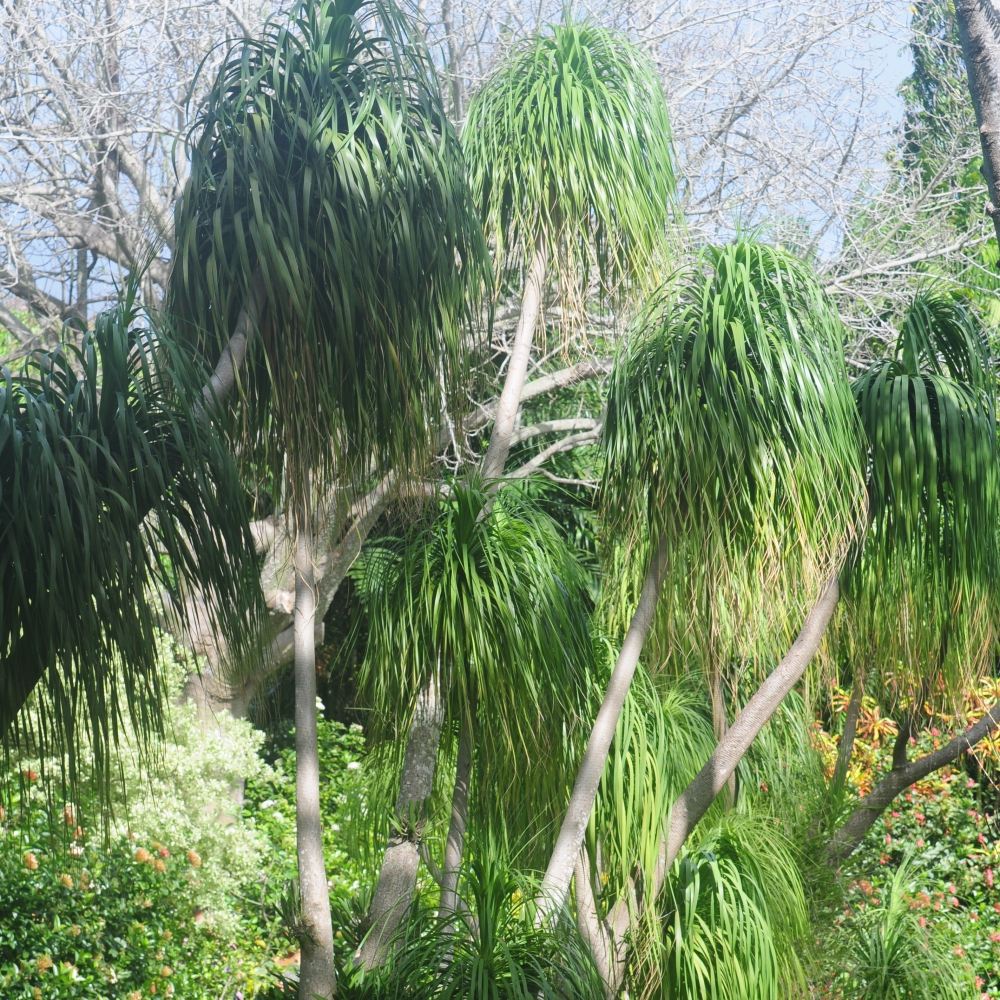The Palm House at Kew
A full six days after getting off the plane from Barbados I found myself in the tropical Palm House at Kew Gardens. It's some years since I've been in here and now with a little more knowledge (but not much more) I enjoyed the heat and atmosphere, complete with song birds (well, a robin).
The Grade I listed Palm House was built in 1844, designed not by Joseph Paxton as I'd always thought, but by Decimus Burton. It was built specifically for tropical plants brought back by Victorian plant hunters. The glasshouse is thought to resemble the upturned hull of a ship and indeed some ship-building techniques were used in its construction.
"The Palm House recreates a rainforest climate, a living laboratory supporting a diversity of plants from the tropical regions of the world, all under one roof. The plantings simulate this multilayered habitat, with canopy palms and other trees, climbers and epiphytes down to the shorter understorey plants and dwarf palms. Many plants in this collection are endangered in the wild, some even extinct. There are many species here studied by Kew scientists for research into medicines."
There are plants aplenty here that grow in the Caribbean - bananas, plantains, hibiscus, gingers, more palms than you can shake a stick at, plus coconuts and sugar cane. And from the far east, orchids and spices - pepper, vanilla, and the "Marmite" plant - bamboo. From Australia there are macadamias, from South America Brazil nuts.
As a garden designer the main attraction of tropical plants is their sheer exhuberance - the rate at which they grow due to high levels of light and moisture, the varied size, shape and texture of their foliage and (usually, though not at this time of year in this country it seems) the bright colours of their flowers.
The quality of light, particularly how bright sunshine (on a March day) filters through the foliage is rather fab, creating strong archtectural shadows and a green, almost underwater atmosphere.
The planting wouldn't appear anywhere as spectacular were it not for the architecture of the Palm House itself. It may look like an upturned hull from the outside but on the inside there's more than a whiff of Paddington Station.
The soaring arches and seemingly impossibly narrow ribs of wrought iron create and ornate backdrop to the plants.
And, as many people know, I can't resist a bit of rust, patina and condensation. The maintenance of the building must be a costly and time-consuming exercise. Is this why the entrance fee to Kew Gardens is £17?
Although the original design was reined in somewhat there are the customary Victorian flourishes showcasing what could be achieved for this new method of manufacturing iron.
The curved ceilings are designed to capture the maximum levels of sunshine. Only later was it realised that many tropical plants prefer shade and dappled light so manganese oxide-free glass, tinted green with copper oxide was installed to diffuse solar gain and approximate the light conditions in a tropical forest.
On a sunny spring afternoon the sun was setting directly behind The Palm House, creating spectacular shadows and from the outside the whole glasshouse looked illuminated.
The Royal Botanic Gardens, Kew - https://www.kew.org/
To read more about the design and construction of The Palm House - http://www.engineering-timelines.com/scripts/engineeringItem.asp?id=97
2018 - A good year?
Is 2018 - a good year to remember, or not? Maybe not for some reasons, but, politics aside, ignoring natural and man-made disasters, bad tempers and bad news in general, here is the good news round up of 2018 in the small corner of the world occupied by Arthur Road Landscapes.
A new year, a new day and a new camera on the beautiful island of Barbados. Not too much in the way or horticulture here but when the landscape looks like this who needs a garden?
But of course I couldn’t resist another visit to Hunte’s Gardens.
Having cleverly avoided the Beast from the East, but running full pelt into the Mini-beast, I made a beeline for the Palm House at Kew for a bit of warmth and humidity.
The cold winter and the sudden arrival of a very warm, but late, spring (who knew what was to come?) meant a very good year for bluebells. This little woodland of oak and ash was discovered by my parents in deepest Berkshire.
May means Chelsea. This was my favourite garden, by Sarah Price. Not everyone’s cup of tea, but definitely mine, I’m just waiting for a commission for somewhere in the Med…
At the end of May I visited Lukesland on the edge of Dartmoor. Spring was a little later here so this Wisteria was still in its full glory.
June sees the climax of our native wild flowers. Driving around Surrey I love the road side verges covered primarily in ox-eye daisies. Parts of the M25 are quite spectacular, something to enjoy whilst sitting out a traffic jam. It’s quite tricky finding somewhere to park and photograph them (I haven’t stopped to take any photos on the M25 I hasten to add).
The heat wave started around the middle of June I seem to remember. I went to Loseley Park before the weather began to take its toll and the White Garden here was looking splendid. Of course the thing about white gardens is that they’re not completely white.
July and August seem to have been swallowed up in a blaze of sweltering heat and guilt about using a hosepipe (sorry/not sorry) but at the end of summer I went to The Homewood in Surrey. I hadn’t expected much of the garden but even I was charmed by the heather, Scots pines and rhododendrons.
A very busy autumn meant little time for visiting gardens but I did manage to get the odd half hour or so on Wimbledon Common. Being outside in bright sunshine whenever possible is my way of dealing with short days and long dark nights.
This is beginning to sound like I haven’t done much work in 2018. Well it’s been a funny old year, a mixture of feast and famine. This sweet little courtyard in Twickenham was completed early in the year. The owners are bird mad so hopefully this spring will see a few new residents in the bird boxes.
A large back garden project which has taken a couple of years, was finally planted in October. There’s not too much to see plant-wise at the moment but I’m looking forward to seeing it develop next year.
Maybe not a vintage year but not a bad one either.
Like these photos? Follow me on Instagram.
A different view of Barbados
I had another fabulous holiday in Barbados this year. Here are some of my favourite photos, possibly not the sort you'd find on a holiday website.
Cobblers Cove Hotel
Every year the Barbados Horticultural Society manages to persuade some of its members to open their gardens to the public. The last open garden of the year was the Cobbler's Cove Hotel in St Peter.
Every year the Barbados Horticultural Society manages to persuade some of its members to open their gardens to the public. The last open garden of the year was the Cobbler's Cove Hotel in St Peter.
his boutique hotel is owned by the Godsall family. The garden is as much of a draw as the luxurious rooms and beautiful setting on the coast
The garden has undergone a gentle upgrade under the eye of garden consultant Niki Farmer. From my conversation with her it has been an enjoyable job, despite the fact the owner doesn't like yellow flowers or variegated leaves.
All the rooms and suites open out onto or look over probably the most immaculate garden I've ever seen.
There are many tropical and meditteranean plants and flowers familiar to us in the UK, usually as house plants, such as Bourgainvillia, Brugmansia and dozens of different palm trees.
Some are less well-known, as plants anyway, such as this Ylang-ylang tree, whose flowers are used in many perfumes.
One of the guests had not checked in but was making himself at home anyway. I was just dying for this green monkey to nip in to the room and help himself to the hotel soap, but he was very well behaved.
The green monkeys are not native to Barbados but come orginally from Gambia and Senegal. Over 75 generations they have developed different behaviours and characteristics to their ancestors.
Its amazing to think this garden is just a few metres from the beach. Shelter from the prevailing winds, plus plenty of sunshine and rain, makes Barbados gardens lush. Large trees can reach maturity in just 25 years.
Brightly coloured flowers can co-exist in close proximity with shade-loving ferns, something that's almost impossible to achieve in the UK.
Of course there were refreshments. Tea, naturally, iced-coffee and, rarely to be found in an NGS garden, rum punch. The icing on the cake was a plentiful supply of fresh Bajan fish cakes, so hard to find after the strange disappearance of the world famous fishcake stall from Speightstown.
Cobbler's Cove Hotel - http://www.cobblerscove.com/
Niki Farmer doesn't have a website but I'm guessing she can be contacted through the Cobbler's Cove Hotel.
Ole Dam Mikkelsen's garden
Ole Dam Mikkelsen has made this magnificent garden in Barbados from an abandoned sugar cane field in just 33 years. It is full of huge trees, orchids, cacti and palms - only in the tropics can trees this size reach maturity in such a short time.
The tree on the left I was told is a coolie nut tree from Brazil. I've tried to look it up without success.
I hope you will bear with me in my ignorance of most of the plants in this garden. It is extraordinarily difficult to find the names of plants just by googling "tropical plant with stripey leaves" for example, or "tree with spikey bark from Barbados". The flower above is called Cat's whiskers but I've no idea what the Latin name is.
This one, Hura crepitans, is known locally as the sandbox tree, monkey no climb and also the dynamite tree (the sound the fruit makes when it splits). The sap has been used to poison fish and the unripe seeds were sawn in half to make sandboxes for pens.
One of the main features of this garden was the variety of trees. This one, I have found, is the Silk Tassle Tree.
This tree featured on a Gardener's World programme recently but I can't find the episode to get the name.
However, even I could identify tiny mangoes.
And breadfruit, although I've still never eaten one. Breadfruit trees (Artocarpus altilis) were brought to the Caribbean by Captain Bligh from the South Pacific for the express purpose of feeding slaves. It is one of the highest yielding fruit trees, producing up to 150 fruits a year, each weighing up to 6kg. Nutritionally it is still an important food, high in vitamins C and B3, potassium and omegas 3 and 6.
What on earth is this? There was a row of them, each about 10m tall.
And these are the roots of a large fig tree, looking like a box of snakes.
The foliage, mostly evergreen, is pretty spectacular as well.
Not always very friendly, unusual for Barbados.
The flowers are vivid in colour and dramatic in form. This is Adenium obesum, known as the desert rose in Barbados, although it is thought to have come from East Africa originally. It flowers in the dry season (winter in Barbados) when most of the leaves drop off, leaving just these flourescent flowers on display.
Here are the stripey leaves. I doubt I would plant this in a garden in the UK but here it looks fab.
This is some sort of semperviven, or maybe an aloe..
Now, where's that rum punch?



































































